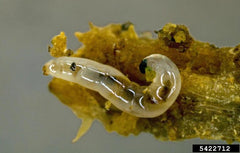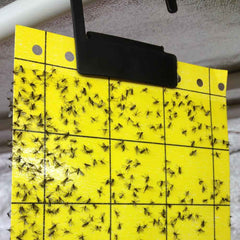How To Deal With Fungus Gnats Organically
Fungus gnats (Ofelia and Bradysia species) are tiny flies similar to mosquitoes in appearance, though smaller at only 1/16th to 1/8th of an inch long. You may notice fungus gnats when you disturbing the soil or flying around near your lights. Females lay eggs in the soil and the larvae have a shiny black head and a whitish/translucent body.
While the adult fungus gnats don't damage plants or bite people, they can be annoying to find in your grow space and the larvae can be damaging the plant. Fungus gnat larvae consume organic matter, compost, fungi, and root hairs.
 *
*
And just in case you wanted to be a bit grossed out:
One potential issue with using organic soil that contains living microorganisms is the potential for fungus gnats. It is always a good idea to monitor your growing environment through the use of colored sticky traps that will attract insects and let you see what's going on in your room. Chunks of raw potato placed in pots with the cut sides down can be used to monitor for larvae.

Keys to controlling fungus gnats are as follows:
Water and Soil Management
1. Keep the soil evenly moist, and avoid overwatering. Make sure your soil mix has good drainage. Mulching can also help to disrupt the cycle. Blumats are a great option for improving your irrigation.
Biological Controls
1. Beneficial nematodes (Steinernema feltiae) are microscopic worms consume larvae and offer protection against both fungus gnats and thrips. There are even now timed release options from Biobee that we offer.

2. Rove Beetle (Atheta coriaria or Dalotia coriaria) is a soil dwelling beetle that feeds on small insects and mites. We find these naturally occur in rooms using our soil mix over the course of a few cycles and believe it's from the Oly Mountain Compost. It's a good generalist predator, though I prefer SF nematodes for a targeted fungus gnat treatment.
 *
*
3. Hypoaspis (Stratiolaelaps scimitus Womersley) is a predatory mite that lives in the soil and feeds on small insects and larvae. These mites will help control a variety of pests such as fungus gnats, root mealybug crawlers, and spider mites).
 *
*
4. Bacillus thuringiensis, subs. israelensis is a species of bacteria that works by the bacterial endospore being consumed by the larva which leads to death. There are a few products on the market that have this as the active ingredient such as Gnatrol, Mosquito Bits, Mosquito Dunks, etc..


Natural/Organic Pesticides
1. Neem or Karanja Cake contain a secondary metabolite called azadirachtin which has been found to act as an antifeedant and growth disruptor towards insects. Add a couple cups of either neem or karanja seed meal to a 5 gallon bucket and then stir vigorously a few times or aerate for a period of 24-48 hours so the seed meal has a chance to solubilize. Then water the surface or any exposed surfaces of the soil. This will kill most larvae, however a few applications, 3-4 days apart is recommended for breaking the life cycle. I have used this method though when dealing with really bad infestations. Keep in mind that you may be killing off some of your beneficial predators/insects as well and would want to re-introduce them through aerated compost teas and adding more of the bugs listed in the above section as a future preventative due to its non-target organism effect.

2. Synthetic derivatives of azadirachtin are available commercially as well in products such as Azamax or Azatrol. These products are typically OMRI approved, and do work well for controlling larvae. Personally I prefer to use neem cake or karanja cake because it contains more than just azadirachtin. Here's a good article explaining why: Functional Blocks of Neem Oil
3. Diatomaceous Earth may be effective at controlling fungus gnat larvae as well. It can be top dressed in the container and will also provide a small amount of silica over time. However it loses effectiveness when it gets wet, which makes watering problematic and is not my first choice for battling fungus gnats.
Conclusion
Managing fungus gnat populations is important, but if you're using the above biological controls or just see a few adult gnats on your sticky trap from time to time, don't freak out. Having a few in the room is not a problem and provides a food source for the beneficial predators. In addition, fungus gnats are helpful in the sense that they consume and break down organic matter. It's all part of the natural food cycle and your goal is to maintain a balance, not necessarily completely eradicate them.
Resources and Photo Credits:
Colorado State Extension Service




